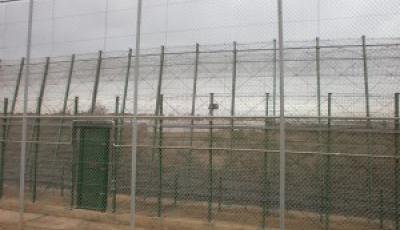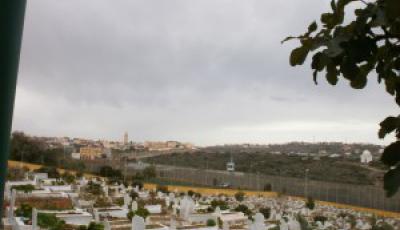Guest post by Ignacio Urquijo, field researcher with the Human Costs of Border Control project by the VU University of Amsterdam. Ignacio is on Twitter @NachoUrquijo.
José Palazón laughed when we asked him if the conversation could be recorded. ‘They are listening anyway.’ Who are ‘they’? According to him, the Guardia Civil. Palazón is the director of the NGO Pro.De.In. and has recently attracted a lot of media attention because of his fight for the rights of the migrants who are trying to enter irregularly to Melilla. He was the author of an instant iconic photograph, which went viral on social media networks last year. The image shows a group of migrants atop the fence separating Morocco from Melilla. The migrants look on from this position at some golf players who nonchalantly continue with their game on the Spanish side.
During the month of September 2014, a team of field researchers tasked with the creation of the ‘Deaths at the Borders Database’ visited Melilla. The Spanish enclave in the north of Africa has been frequently in the news due to the attempts of many people, mainly from Sub-Saharan Africa, to climb its border fence. The ‘Death at the Borders Database’ is ‘the first collection of official, state-produced evidence on people who died while attempting to reach southern EU countries from the Balkans, the Middle East, and North and West Africa, and whose bodies were found in or brought to Europe.’ This Database, directed by Tamara Last, is part of a five-year project based at the VU University of Amsterdarm, supervised by Thomas Spijkerboer. The objective of the Spanish field researchers, Marta Pérez and myself, in Melilla was to collect data related to people who’ve died trying to enter the European Union. This task required visiting the civil registry of the jurisdictional area to look for death certificates. Whereas authorities have the obligation by law to register all bodies that appear in their jurisdiction, so far this information isn’t compiled in a comprehensive way, meaning that the data are spread through hundreds of European civil registries.

The pictures below (by Igancio Urquijo) depict the fence separating Morocco from Melilla, revealing other details, such as the door in between the fences used for the ‘on-the-spot deportations,’ which have been strongly criticized by non governmental organizations.

‘But how many, roughly?,’ we insisted. ‘Since when?’ ‘Since the beginning of the nineties.’
Palazón looked away. There were some kids cheerfully playing with a ball in the square where we were drinking our coffees. At the same time, a group of athletic guys wearing sport jackets with the distinction of the Spanish army run past in what looks to be their daily routine. Finally he answered.
‘I can’t tell you, it’s impossible to know. Too many.’
The next morning, in a quiet office hosting the Spanish flag, the spokesperson of the Spanish delegation of the Government in Melilla began her answer to that very question with similar words, but offered a different ending: ‘I can’t tell you, I can’t officially tell you. But they are just a few.’
In the civil registry of Melilla we found records of 79 people who died trying to enter the city since the year 1990 to the end of 2013. Some of the most common causes of death indicated in the certificates were ‘drowning’ (many people tried to swim from the Moroccan coast to the Spanish one) and ‘injuries sustained from fall’ (around the fence and also from the cliffs which are close to the border). There was also a person registered to have been shot at the border fence. This number only represents those who have died and have been registered by the Spanish side of the border. It excludes all those whose bodies were located in Morocco.
The information found in Melilla, in addition to the data collected in more than 500 locations in Greece, Italy, Malta, Spain, and Gibraltar by more than ten researchers, is now available in a public database which can be access here. The database provides a clearer answer to the question ‘How many people died?’ When available, it also provides some information about those who died at the border, such as place of origin, age and gender. However, this data will not be complete or fully meaningful without the collaboration of the authorities on all sides of the Mediterranean.

__________
How to cite this blog post (Harvard style):
Urquijo, I. (2015) How Many Migrants Died Trying to Enter Europe? Available at: http://bordercriminologies.law.ox.ac.uk/death-at-the-borders/ (Accessed [date]).
Share:








